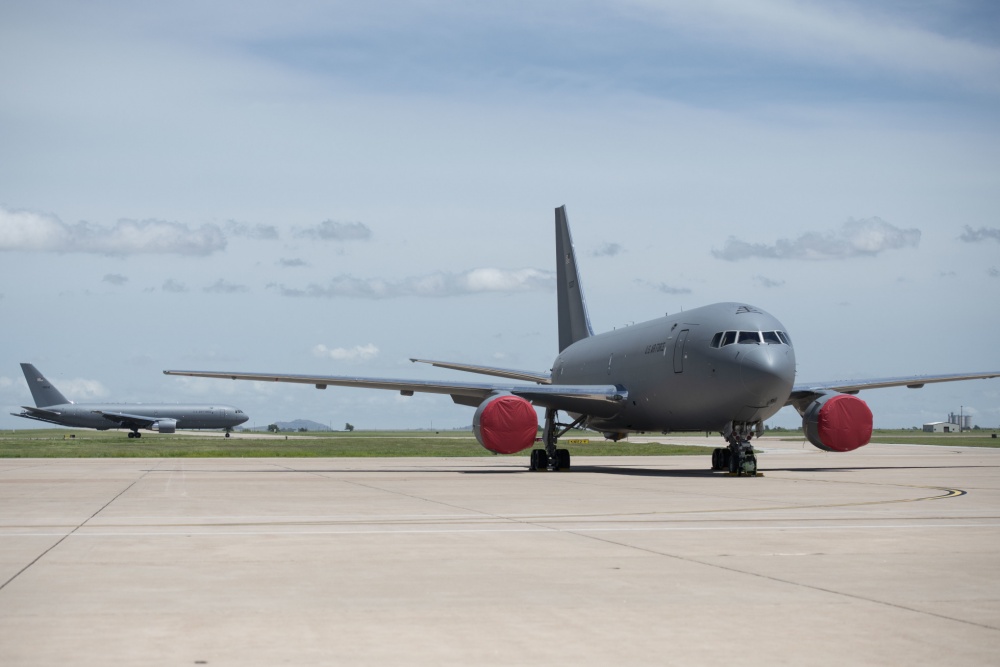
A KC-46 Pegasus lands on the flight line, May 18, 2019, at Altus AFB, Okla. Air Force photo by A1C Breanna Klemm.
Air Mobility Command is pressuring Boeing to speed up its fixes for multiple Category One deficiencies on the KC-46 tanker, especially the aircraft’s remote vision system.
“I’m looking at the fact that we’re eight months into accepting our airplanes, and Boeing has not presented a solution that has met all the parameters,” AMC boss Gen. Maryanne Miller told reporters Sept. 18 at AFA’s Air, Space & Cyber Conference. “In a couple months, that’s what I’m looking for,” meaning a fix that can meet all the Air Force’s requirements.
“We’ve got to get this airplane into the fight,” she asserted.
Of the four Category One deficiencies affecting the jet—including a recently discovered issue with flawed cargo locks, announced in early September—the remote camera and sensor system used by the boom operator to guide the refueling boom to refuel receiving aircraft is the most critical.
The Air Force identified nine critical parameters Boeing must fix. The company is working with USAF scientists, Miller said, and the combined team has been “making progress” on seven of them. But two have proven “very difficult.” These include a problem with the acuity, or definition, of the display; with the current, flawed system, the boom operator’s vision is akin to 20/50 vision, Miller said. Depth perception is also a problem, making it particularly difficult for operators to know how far the boom is from the receiving aircraft.
Boeing “knows it has to meet all nine,” Miller said, calling AMC’s evaluation process a “pass/fail” matter. Failing to solve any one parameter counts as failure. Miller promised to “increase the pressure,” but did not specify what means would be applied. “The pressure’s on to get this into the fight,” she said. “Our teams will work together to get this into the fight.”
Speaking for Boeing, Mike Hefer, the company’s senior manager for KC-46 business development, told Air Force Magazine that the Air Force and Boeing have a memorandum of agreement regarding the RVS.
“Maybe we had some fault on both sides defining what the system should look like,” he said. But “we’ve established very objective data now on what the RVS should be able to perform. We’ve gotten the green light from the Air Force to build, upgrade, and enhance the RVS system, to meet all those critical performance parameters. So we’ve got a clear path forward.”
Because of the delay, AMC is working now with Air Force leaders on solutions, including the potential for slowing down the retirements of the KC-135. US Transportation Command said earlier this year that it needs to retain 28 more KC-135s because of delays to the KC-46. Miller said Sept. 18 that “if the KC-46 is delayed, we will continue to work with the Air Force. I’d love to slow down the retirement because I have to keep booms in the air.”
Last week, AMC announced the new Category One deficiency focusing on the locks that keep cargo in place on the plane. The restraints appeared to come unlocked during multiple flights, prompting AMC to bar cargo and personnel from flying on the plane.
Boeing is proposing a two-step solution to the issue, including an interim step of using tie-down straps to allow the planes to fly with cargo again. Longer term, the company is proposing a “robust” fix to address the issue permanently. Miller said Sept. 18 she had not yet been briefed on the proposal, but emphasized her interest is in permanent, not interim fixes, for Category One issues.
According to Hafer, “nothing came loose” in the incident that triggered the order barring cargo and passengers from KC-46 flights. “It stayed secure the whole flight,” he said. “At no time was there a safety of flight issue. It just did not indicate a full lock.”
Boeing suspects vibrations caused the indicators on the clamps to shift from locked, to “off center.” Although he offered no timetable, Hafer promised, “We can get that fixed.”
“We’re doing the full root cause analysis,” Haver said. “We need to verify our solution,” he noted, saying “our solution is being put to the test right now. Once that analysis is complete, we turn that analysis over to the Air Force.”
Nevertheless, it’s Category One Deficiency Report, he admitted. “We don’t walk away from it, we acknowledge it and we fix it.”
Earlier this year, the Air Force and Boeing resolved issues with foreign object debris in the aircraft, with the most recent delivery—airframe No. 19—being completely FOD free, Miller said. Miller expressed confidence that the problem was addressed, but the service and the Defense Contract Management Agency will continue its oversight.
The aircraft is still flying its pre-initial operating test and evaluation sorties, and airmen are still excited about the plane.
“It provides great capability,” she said. “We’ve got issues we’ll work through them. I’m confident we’ll work through all the Cat Ones. We’ll get it in the fight in the next four years.”
